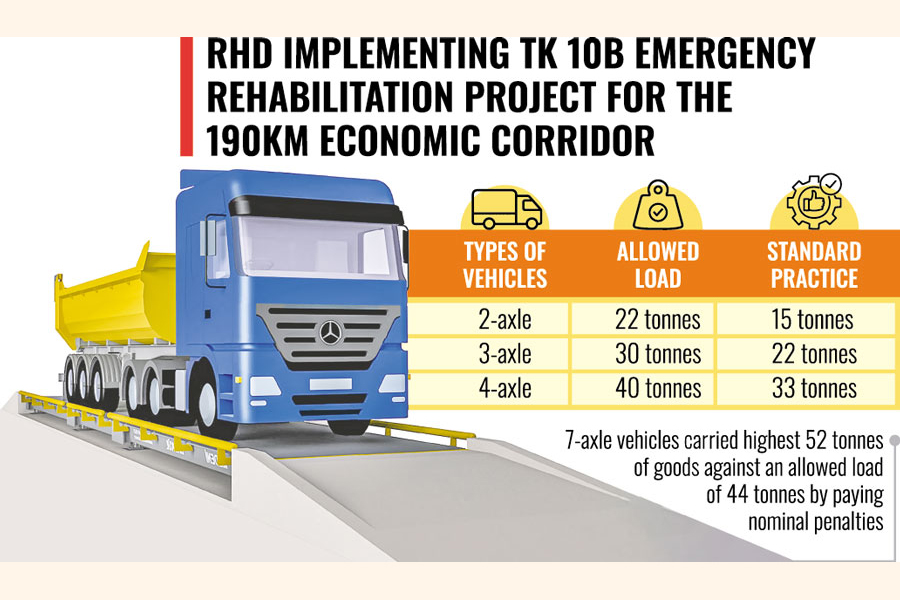DHAKA-CHATTOGRAM HIGHWAY
Overloaded vehicles cause annual damage worth at least Tk 8.61b
Latest RHD study estimates

Published :
Updated :

The damage caused to the Dhaka-Chattogram highway due to the overloading of goods-carrying vehicles is estimated to be at least Tk 8.61 billion annually.
The assessment, conducted by the Roads and Highways Department (RHD), even deducted the costs associated with the savings on excess load transported and less consumption of fuel from the damage estimation.
The ousted Awami League government allowed transports with much higher loads than the highway's design capacity, officials say, amid demands from businesses.
They argued that allowing overload would help reduce the requirement for vehicles for transportation of the same quantity of goods, easing traffic congestion and saving fuel consumption, said the officials.
The RHD has been implementing an emergency rehabilitation project worth Tk 10 billion since 2023 to make the economic corridor usable.
The study shows the damage to the 190-kilometre highway would be a gross amount of Tk 12.31 billion based on data analysis of overloaded vehicles and quantity from Sitakundu Axle Load Station in FY 2023-24.
It also found an amount of Tk 3.70 billion was saved due to transportation of excess quantity of goods, considering 15 tonnes per 2-axle trucks as per allowable limit of the road's design capacity.
However, officials and transport experts thought that the study findings reflected only a glimpse of the intensity of damages caused to the lifeline of the country's economic corridor that transports 90 per cent of the country's export and import goods.
They said the actual losses would be countless if transportation from land ports located in other parts of the country through the 22,000 km highways and regional highways are considered.
"Actual loss would be much higher if the study counts losses caused by the road accidents due to overloading, vehicle damages along with depreciation for violation of manufacturers' specifications, increased travel time and carbon emissions," said Dr Mohammd Mohasin Howlader, who led the study.
The additional cost for major upgrades of the pavement and periodical maintenance of the roads due to overload was also excluded in the study on the country's prime road corridor, he added.
Presenting a paper at a stakeholders' meeting at RHD recently, Dr Mohasin also highlighted that the damage factor of vehicles due to overloading was 7.4 times in 2-axle vehicles, 2.27 times in 3-axle vehicles and 2.3 times in 4-axle.
The RHD study on Sitakundu Axle Load Station also found common practices of breaking the allowable excessive limit.
The allowable limit of a 4-axle vehicle increased to 40 tonnes from 33 tonnes, but many vehicles carried 44-52 tonnes by paying fines as per the office orders in 2019.
The previous government changed the axle-load policy several times during 2016 to 2020, allegedly compromising with the party leaders, including Shahjahan Khan and Moshiur Rahman Ranga.
Different government agencies also violated the axle load limits while carrying equipment and raw materials for different power and infrastructure projects, including the 3rd terminal construction project of Hazrat Shahjalal International Airport in Dhaka.
Professor Mohammad Shamsul Hoque of Bangladesh University of Engineering and Technology (BUET), who has been vocal against overloading for the last 15 years, said that axle load control is a must for the sustainability of the country's road infrastructure.
He said maintaining load through axle control is necessary to match with the international standard and it can be checked by stopping changes in career size of vehicles by the stakeholders.
As Bangladesh is a signatory of UN treaty and UN Convention on road and motor transport 1949 and Vienna convention 2019, Professor Hoque also said that to match with the country's economic growth as a middle income country, Bangladesh must comply with the international standard as none of the neighbouring countries and other countries have such practice of overload and modification of container size.
A land port official also said Indian trucks come with goods not beyond 18.5 tonnes for two-axle vehicles and 22 tonnes for three-axle ones as compared to 22-30 tonnes in Bangladesh.
At present, only the Sitakunda Axle Load Station is only under full operation. Three other stations were either damaged allegedly by the hooligans to continue the ill activity or turned inoperative with the help of unscrupulous groups of station operators.
The Road, Transport and Highways Division allowed loading 22 tonnes against allowable 15 tonnes for two-axle vehicles and it went up to 40 tonnes with the increase of seven-axle or 14 wheels.
However, the seven-axle ones carried up to 50 tonnes against the permissible limit of 35 tonnes, taking advantage of a nominal amount of fine under the same office order 2019.
The vehicles with two-axle, two wheels on the front and two others on the back, can carry 5.5 tonnes and 10 tonnes respectively, which can be increased with the increase of one axle.
smunima@yahoo.com


 For all latest news, follow The Financial Express Google News channel.
For all latest news, follow The Financial Express Google News channel.